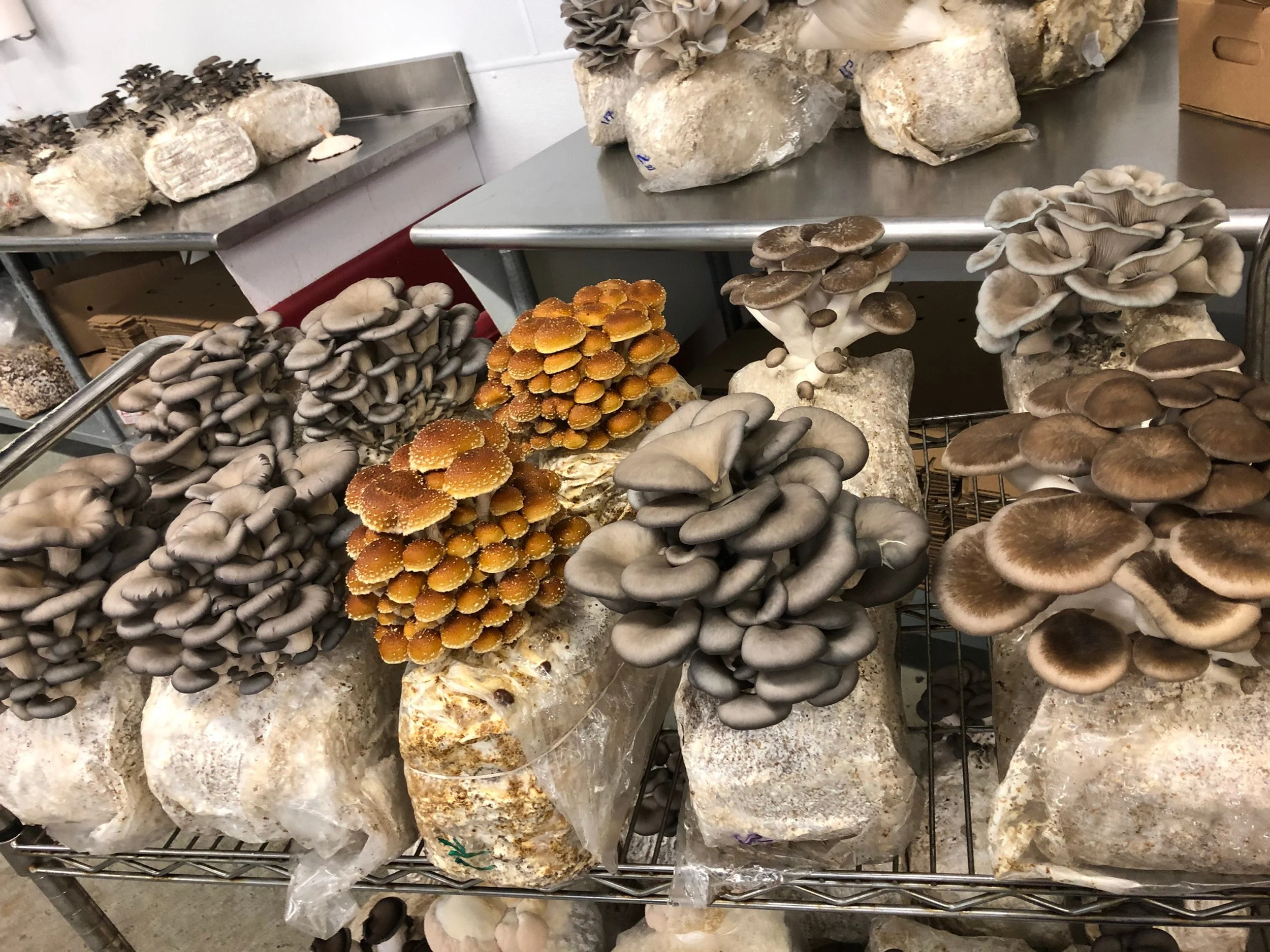FREQUENTLY ASKED QUESTIONS
What Are Mushroom Blocks?
Commercial farmers grow culinary mushrooms in plastic grow bags filled with a sterilized, organic blend of sawdust, grains, and nutrients that feed the mycelium (white stuff). NO SALTS USED The bags are kept on shelves in a controlled environment that simulates the temperture (65-75°F) and humidity (80-90%) that is ideal for the mushrooms. Once the block is fully colonized and covered with mycelium, it is ready to fruit. The bags are cut open to allow in enough oxygen for the mushroom to fruit. After 3-7 days, the mushrooms are ready to harvest. The blocks are donated to be composted or to grow more mushrooms. This is why the bags are already open.
WHERE DO THEY COME FROM?
From commercial mushroom farms in central Texas. Many times mushroom farms grow mushrooms once, and then end up getting tossed in the waste. In Austin, we are collaborating with a local mushroom farms to help keep used mushroom blocks out of the waste to give people the opportunity to grow them using various methods.
If you don’t live in Austin contact your local mushroom farm to see if you can take mushroom blocks to compost. Visit our map of Texas Mushroom Companies.
How DO I Grow ANOTHER FRUITING oF MUSHROOMS?
Keep mushroom block in the existing plastic bag and place out of direct light in a cool environment at 65-75°. A Martha Tent or Shotgun Fruiting Chamber is a great idea to contain the spores and helps create a humid environment when temperatures are too hot outdoors.
Spritz with water 2-3x per day
After about 2-3 weeks, the mycelium (white stuff) will start to develop “pins” or baby mushrooms.
Water more frequently and in 2-5 days a “flush” of mushrooms will be ready. Harvest with a knife before the caps curl up!
Compost after harvest.
WILL MUSHROOM BLOCKS GROW ANOTHER MUSHROOM THAT IS POISONOUS?
No, a mushroom grow block will not randomly grow a poisonous mushroom. The block is inoculated with a specific fungal species, and unless contaminated by another fungus, it will only produce the intended mushroom. However, if once opened and exposed to wild spores, other fungi like green mold or trichoderma will colonize it. This fungus is really beneficial to plants and actual prevent other fungal pathogens. Learn more about benefits. Always have an expert identify any unexpected growth before consuming!
DOES THE MUSHROOM BLOCKS CONTAIN SALTS THAT WILL HURT MY PLANTS?
NO! Many studies on mushroom compost like this one advise against using a lot of mushroom compost because they contain high salts. NO SALTS are used in the process of growing gourmet, culinary mushrooms like oysters and lions mane. These are WOOD-LOVING mushrooms and they grow on sawdust, grains and nutrients.
Mushroom farm such as Kitchen Pride (which we don’t work with) produce white button mushrooms such as cremini and portobello. These are DUNG-LOVING or mushrooms that grow on manure and have soluble salts used in the process. This type of compost contains high levels soluble salts that can harm young seedlings and kill germinating seeds. Since these are a very common mushroom grown and there are a lot of research and content about spent mushroom compost it appears at the top of search results.
What Kind of Mushrooms Are THey?
Look for a tag with a code on the bag and also look at the hole in the bag to determine variety. The top three are the most common.
🌀 B- Blue Oysters
Flavor: Sweet and meaty with hints of licorice. Perfect for braising, sautéing, roasting, frying, grilling, and stir-frying.
💛 G - YO: Golden or Yellow Oysters
Flavor: Mild, nutty flavor. Cooked until golden and slightly crispy with a little butter and garlic. Try making an oyster mushroom “steak” recipe.
🦁 L - Lions Mane
Flavor: Tender texture that mimics shellfish like scallops, crab, or lobster. A great alternative to seafood. Read about medicinal values.
C-Chestnut
Earthy aroma and mildly sweet flavor with distinct hints of nuttiness. Commonly compare their flavor to shiitakes.
P - Pink Oyster
Taste like bacon or ham, and the flavor intensifies when cooked. The aroma is pungent and meaty wonderful meat substitute in many dishes.
O-Pioppini
Earthy, nutty flavor with subtly sweet, floral, and peppery note. Popular in pasta dishes and risotto.
E-Enoki
Mild, delicate, and slightly sweet. They have a subtle crunch and a chewy texture that makes them a great addition to salads, soups, and stir-fries. Often described as nutty, with a hint of earthiness that adds depth to dishes.
A-Local Oyster
Some people report a seafood-like taste while others just say woodsy — it probably varies a bit depending on the environment it is growing
D-Black Pearl
Meaty yet airy flavor with hints of sweetness. When cooked, it packs a savory punch and is a reliable ingredient for adding umami flavor to a dish.
GROWING TIPS
KEY ELEMENTS NEEDED FOR GROWING
HUMIDITY
Ideal humidity is 80-90% so spray with filtered water 2-3 times a day and keep in a humid area. Try putting them inside a cardboard box or container to contain humidity. Just remember air flow and light are also important.
Air Circulation
Mushrooms give off carbon dioxide and intake oxygen so give them a space for air circulation.
If you see green, moldy spots, then feed the block to your compost. Green mold is great for plant growth.
LIGHT
During the colonizing stage (3+ weeks), keep your mushrooms in a cool, dark place below 80°. Once you see “pins” aka baby mushrooms, give your mushroom more light and oxygen. UV light is how mushrooms create vitamin D.
GROW INDOORS: (Anytime)
Leave in the bag and put in moist area like a kitchen or in bathroom, place into a plastic tote, cardboard box, greenhouse or humidity tent.
Air circulation is important. Turn on overhead fan or place fan facing away from mushrooms.
Keep Moist: Spritz with water on slit daily. Keep an eye out for pins (tiny mushies), water 2 - 3x a day.
Harvest after 3 - 5 days before the caps start to curl up and spores drop.
Compost or use as mulch in garden.
GROW OUTDOORS: (Fall-Spring)
Leave the block in the existing bag and place it in a shady spot under a tree or shrub, on your porch.
Keep it moist, water daily. They love rain water so make sure they can get exposed.
Keep an eye out for pins (tiny mushies), water 2-3x a day.
Harvest after 3 - 5 days before the caps start to curl up.
Compost or use as mulch in garden.
Left: caps still folded down, not dropping spores. Perfect to harvest
Right: edges flattened upwards. Dropping spores now, great to eat but take it outside
ADDITIONAL TIPS
Fold the bag over the slit to retain moisture until you see tiny mushrooms. If possible, keep the square white filter patch directly accessible for airflow.
Spritz water around the mushrooms (not directly) for best results.
Mushroom blocks make liquid over time! Just pour it out!
After a few times fruiting, the block will be done. Unbag, smash, and compost!
How to Use as Compost
Smash up entire contents of bag and sprinkle in garden beds, around the base of trees with mulch, or mix in your compost pile. Dispose of plastic bag in the trash.
Benefits of Recycling Mushroom Blocks
Great for soil health
Supports the ecosystem
Keeps methane out of landfills (good for climate!)
Fill your belly with delicious and nutritious organic mushrooms for free
Support your local mush community!
learn more ways to COMPOST & grow mushrooms OUTDOORS in the garden and sign-up to get recycled mushroom blocks.
IMPORTANT ALLERGY PRECAUTION
Spores can cause problems indoors for people with allergies. Keeping them in sight is important. If you are going out of town for an extended period put them outside because mushrooms can grow and spread spores in 5-7 days. If you see any mold forming on your block, use a spoon to break it off and dispose of it immediately outdoors. Mold spores, like mushroom spores, are not good to inhale in large quantities.
HOW TO SUPPORT THIS INITIATIVE
Help us continue this waste diversion initiative by leaving us a donation. (Suggestion is $5 per block). We are using the money to build a mobile lab and community mushroom spawn library to continue mycology education throughout Texas.
Central Texas Mycological Society is always looking for more members to support our mission of educating the community about the benefits of fungi.












